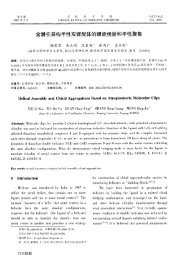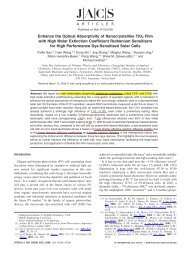Novel hydrodesulfurization nano-catalysts derived from Co3O4 ...
Novel hydrodesulfurization nano-catalysts derived from Co3O4 ...
Novel hydrodesulfurization nano-catalysts derived from Co3O4 ...
Create successful ePaper yourself
Turn your PDF publications into a flip-book with our unique Google optimized e-Paper software.
510 X. Wang et al. / Catalysis Today 175 (2011) 509–514<br />
alytic activity of the sulfided <strong>nano</strong>rods for the COS removal is much<br />
more reactive than that of the <strong>nano</strong>polyhedra. This comparison<br />
has enabled the understanding of the morphology on the catalytic<br />
property of the solids.<br />
2. Experimental<br />
2.1. Synthesis of Co 3 O 4 <strong>nano</strong>crystals<br />
All the materials were of analytical purity and were used as<br />
received without further purification. To obtain Co 3 O 4 of different<br />
shapes, cobalt acetate tetrahydrate (A.R. grade, Beijing Chem.<br />
Corp., China) was used as the cobalt source. The method for the<br />
synthesis of Co 3 O 4 <strong>nano</strong>rods was improved on the base of ref. 23.<br />
4.98 g of Co(CH 3 COO) 2·4H 2 O was dissolved in 60 ml of ethylene<br />
glycol (EG) and the solution was gradually heated to 160 ◦ C. Then<br />
200 ml of aqueous 0.2 M Na 2 CO 3 solution was fed-in drop by drop<br />
for about 5 h and the slurry was further aged for 1 h under vigorous<br />
stirring and a continuous flow of nitrogen. The mixture was then<br />
allowed to cool to room temperature (RT). The final solid product<br />
was collected by filtration, and washed with deionized water to<br />
remove any possible ionic remnants, then dried at 50 ◦ C overnight<br />
under vacuum and calcined at 450 ◦ C for 4 h in air. Co 3 O 4 <strong>nano</strong>polyhedra<br />
were prepared by a direct precipitation method, in which<br />
Co(CH 3 COO) 2·4H 2 O was dissolved in EG at RT, followed by adding<br />
0.2 M Na 2 CO 3 solution slowly. Then the product was obtained after<br />
filtrating, washing, drying and calcinating processes as mentioned<br />
above. All the as-prepared samples were crushed and sieved to<br />
24–40 mesh particle size range and used as unsupported <strong>catalysts</strong>.<br />
2.2. Presulfurization and catalytic activity test<br />
The catalytic reactions were carried out at atmospheric pressure<br />
in a continuous up-flow fixed-bed quartz reactor (8 mm × 45 mm)<br />
heated in an oven. 0.1 g of catalyst was placed on a quartz sintered<br />
plate which located in the center of the reactor. Before the catalytic<br />
evaluation, the oxide catalyst was sulfided in situ with a gas mixture<br />
containing 4.4% H 2 , 1.1% H 2 S (V/V, nitrogen as balance gas, the<br />
flow rate of 25 ml/min) at 300 ◦ C for 3 h. After sulfidation, the catalyst<br />
was cooled to room temperature and was flushed with a flow<br />
of 100 ml/min N 2 for another 2 h. The catalytic activities for COS<br />
hydrogenation were evaluated in reactant gases (0.1% COS, 10%<br />
H 2 , balanced with N 2 , 80 ml/min) under the preset temperature.<br />
The composition of the sulfur-containing gaseous product was analyzed<br />
on-line using a GC-7890II gas chromatograph equipped with<br />
a Porapak Q column and a flame ionization detector (FPD).<br />
2.3. Catalyst characterization<br />
The powder X-ray diffraction (XRD) patterns were recorded<br />
on a Rigaku D/max 2400 Diffractometer using Cu K radiation<br />
( = 0.15418 nm) to identify the phases and crystallinity of the <strong>catalysts</strong>.<br />
The size and morphology of the <strong>catalysts</strong> were observed under<br />
field emission scanning electron microscopy (FESEM, JSM 6700F),<br />
transmission electron microscopy (TEM) and high-resolution TEM<br />
(HRTEM, Philips Tecnai G 2 20). X-Ray Fluorescence (XRF) measurements<br />
were conducted with XRF-1800 (Shimadzu). BET surface<br />
area was estimated by N 2 physisorption at 78 K in an ASAP 2000<br />
Micromeritics instrument. The temperature-programmed reduction<br />
(TPR) of the sulfided catalyst was performed in a 12% H 2 –N 2<br />
mixture at a flow rate of 80 ml/min, with the heating rate of<br />
10 ◦ C/min <strong>from</strong> RT up to 950 ◦ C. The effluent sulfurous gas was<br />
analyzed by GC equipped FPD detector.<br />
3. Results and discussion<br />
3.1. Phase identification<br />
Fig. 1 displays the XRD patterns of the as-prepared Co 3 O 4 <strong>nano</strong>sized<br />
materials and their corresponding sulfided powders. From<br />
Fig. 1(A), it is clear that all the diffraction patterns of both fresh<br />
Co 3 O 4 <strong>nano</strong>rods (abbreviated as “NRs”) and <strong>nano</strong>polyhedra (abbreviated<br />
as “NPs”) can be indexed as the face-center cubic phase<br />
(space group Fd3m) and with a lattice constant a = 0.806 nm, which<br />
are consistent with the values in the PDF card (JCPDS 42-1467). The<br />
broadening of the reflections ascribed to the polyhedra and rods<br />
distinctly indicates their <strong>nano</strong>crystalline nature, and the sharper<br />
reflections for polyhedra implied their larger sizes and/or fewer<br />
defects as compared with the rods. The XRD patterns of two sulfided<br />
<strong>catalysts</strong> <strong>derived</strong> <strong>from</strong> Co 3 O 4 <strong>nano</strong>rods and <strong>nano</strong>polyhedra<br />
are shown in Fig. 1(B), both of them can be tentatively indexed as<br />
the cubic phase of Co 9 S 8 (JCPDS 65-6801).<br />
3.2. Size and morphology<br />
Fig. 2a shows the TEM image of the as-obtained Co 3 O 4<br />
<strong>nano</strong>rods, with a uniform diameter in 5–15 nm and a length within<br />
200–300 nm. Fig. 2b depicts the representive HRTEM image of one<br />
Co 3 O 4 <strong>nano</strong>rod, which has a respective interplanar spacing of 0.286<br />
and 0.467 nm, showing a one-dimensional growth structure with<br />
a preferred growth direction along [1 1 0] [22], similar to the case<br />
of Co 3 O 4 <strong>nano</strong>rods prepared under semblable synthesis condition<br />
by Shen’s group [23]. Fig. 2c exhibits the TEM image of uniform<br />
Co 3 O 4 <strong>nano</strong>polyhedra in the size range of 8–20 nm. The HRTEM<br />
A<br />
(311)<br />
B<br />
(440)<br />
(311)<br />
Intensity /a.u.<br />
(111)<br />
(220)<br />
(222) (400)<br />
(422)<br />
(511)<br />
(440)<br />
NPs<br />
Intensity /a.u.<br />
(222)<br />
(331)<br />
(511)<br />
Sulfided NPs<br />
Sulfided NRs<br />
NRs<br />
10<br />
20<br />
30<br />
40 50 60<br />
2 Theta /degree<br />
70<br />
80<br />
10<br />
20<br />
30<br />
40 50 60<br />
2 Theta /degree<br />
70<br />
80<br />
Fig. 1. XRD patterns of the as-prepared Co 3O 4 (A) and their corresponding sulfided compounds (B) with different morphology. (NRs, <strong>nano</strong>rods; NPs, <strong>nano</strong>polyhedra).
















